The Woad Trip
by Cathy M Koos
Back in the Before Times, my friend Janice and I took a Woad Trip. In this case, the Road to Woad was Hwy 395 waaaay north past Susanville to the tiny berg of Cedarville. Warner Mountain Weavers https://warnermtnweavers.com/ was our destination for a long early May weekend of picking, smashing, boiling, and dyeing with woad.

Bordered by the picturesque Warner Mountains, Surprise Valley is in the northeast corner of California. Nestled along the valley’s edge, Cedarville is a fun little base camp for exploration. Now mostly sheep and cow country, early European settlers traveled through this area on their way to Oregon. Bonnie Chase, owner of Warner Mountain Weavers (WMW) was our host and woad expert for the weekend. Once the Deep Creek Schoolhouse, Bonnie opened her WMW workshop in the late 90s as a hub for local artists and sheep ranchers. Now only open by appointment due to Covid, Bonnie has an amazing array of yarns for knitting and weaving, spinning wheels, looms, and tools, as well as classes.
So, what is woad? Woad, Isatis tinctoria, has ancient European roots back to the Stone Age. With a distinctive cabbage-y odor, woad shares the brassica family with broccoli, brussels sprouts, mustard, and of course, cabbage.
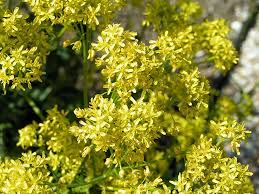
(Wikipedia)
Ancient Picts and Celts were known for painting their bodies with woad before battles, likely because the appearance of a screaming, naked, blue man armed with a spear or axe would terrify their opponents.
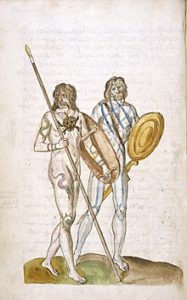
As woven fabrics came into use, woad was used as a textile dye. Woad balls (chopped leaves compressed into balls and allowed to dry) were a highly valuable trade commodity, as evidenced by a 1286 CE trading agreement between foreign woad merchants and the citizens of Norwich, England. 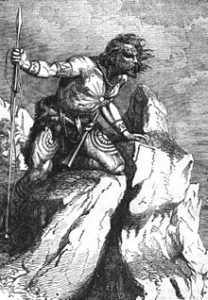
Once maritime travel opened up imports of Asian indigo, however, woad began to fall out of use. By 1932 when synthetic indigo was developed, the last woad mill in England closed.
Woad processing today has not really changed from prehistoric times, beginning with picking the first-year leaf growth. In far northeastern California, late spring/early summer is ideal for the best product. Early our first morning, Bonnie took us out on a little field trip to collect our woad leaves. We were entertained with tales and songs of “Marlahan,” as woad was once known.
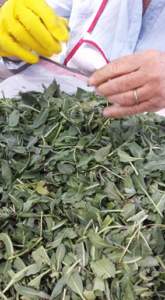
After our morning leaf collecting, we returned back to WMW’s lovely garden to begin the messy task of processing. As in days of old, we finely chopped the leaves and macerated them into paste using a stone metate. From the paste, we pressed a portion into balls to dry and take home to use later. The balance was chucked into boiling water in a large dyepot.
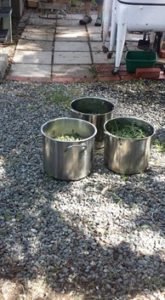
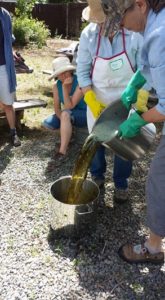
To make the woad dyefast, it needs to be made alkaline with either ammonia, washing soda, or urine. Historically potash, diabetic urine, urine from a pregnant woman, and urine from a man drunk on red wine (yes!) were considered best for the woad dye. Urine was a sought-after commodity back in the day and was set outside cottages for collection by the local dyer or leather tanner. Hence that old saying about being so poor that a fellow didn’t have a pot to piss in. One way or the other, ammonia or urine, woad dye needs to get to a pH of 8-9.
We used ammonia.
Water hardness, a presence of various minerals, is also an important factor. Well water, city tap water, distilled or bottled water will all produce variations in the dye.
Like indigo, the chemical that creates the blue dye is indigin. To release the indigin, create a reduction, and make the blue dye, a product like SpectraLite or Rit Color Remover is used.
Similar to indigo dyeing, careful immersion and removal of the fiber is critical to preventing too much oxygen entering the dyebath.
For our efforts that weekend, we used about 4 pounds of chopped leaves and covered them with boiling water for about 30-45 minutes. Once color struck our silk scarf blanks, they were carefully removed from the dyepot and hung to dry.
Now before you go collecting, make sure you have permission, and you are not trespassing. Usually, permission is freely given because woad is considered a highly invasive plant in the West, but always check. In fact, in Elizabethan England, woad cultivation was limited because it was threatening to invade important grain crops.
You may be tempted to hop online and buy some seeds, but please don’t. While it is attractive to pollinators, there are other, better plant choices to grow. There are many woad patches in California, and you can search the online Calflora site map, link listed below. But be aware that if you find a patch growing along a road edge, it may have been sprayed with herbicide. Have a great Woad Trip!
References:
Calflora searchable state map https://www.calflora.org/app/taxon?crn=4364
University of California Integrated Management Pest Notes (good photos to identify) http://ipm.ucanr.edu/PDF/PESTNOTES/pndyerswoad.pdf
Surprise Valley Chamber of Commerce www.surprisevalleychamber.com